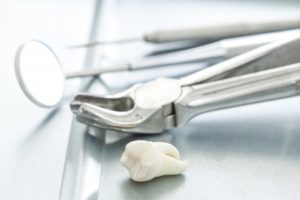
For your entire lifetime, you only get one set of permanent teeth. As a result, you and your dentist should do everything possible to preserve your smile for the long haul. However, when it becomes necessary to remove a tooth, the procedure can be either simple and easy or challenging and complicated. But why? Why makes a tooth extraction more complex than another? And why on earth would you extract a tooth in the first place? In this post, you’ll get answers to these important questions.
Why would a tooth need to be extracted?
Although it is almost always better to save a tooth rather than extract it, sometimes there is no other choice. If your dentist recommends extraction, it could be for one of the following reasons:
- Severe decay or damage to a tooth without enough healthy structure to support a restoration.
- Advanced periodontal (gum) disease.
- Overcrowded teeth that need space in order to receive orthodontic treatment.
- Weak or damaged teeth that should be removed before making a partial or full denture.
- Insufficient room for the third molars, also called wisdom teeth to erupt properly.
Ultimately, removing a tooth should contribute to your smile’s health in the long term. Make sure you understand the reason behind the extraction so that you can feel confident and comfortable moving forward with treatment. After all, removing a tooth is permanent!
Why are some teeth more difficult to extract than others?
Pulling one tooth can require more or less work than pulling another. Why? Well, there are many factors that can make a tooth more difficult to extract. These include:
- The type of tooth. In the back of your mouth, your premolars and molars have multiple roots, whereas your incisors and canine teeth in the front of your mouth have only one. The more roots, the more firmly those teeth are embedded in the bone and tissue, making them more difficult to remove.
- The location of the tooth. The front teeth are much more accessible and therefore a little easier to extract than the teeth in the back of the mouth.
- The extraction method. For some teeth, simply using dental pliers and pulling are enough to remove a tooth. However, other times, such as with wisdom teeth that have not actually erupted yet, more invasive measures may be needed to get a tooth out.
- The reason for extraction. Sometimes the reason can complicate or facilitate the extractions. For example, if you have advanced periodontal disease, the support that your jaw bone and tissues provide for your teeth is likely weakened. As a result, the extraction should be much simpler than if you had good oral health.
Regardless of the difficulty of your extraction, your dentist and their team will make sure that you’re completely comfortable throughout the entire process. They’ll walk you through the steps and help you heal properly. Then, if needed, they can help you find the tooth replacement option that will best meet your needs and restore your smile! For more information about extractions, don’t hesitate to contact your dentist!
About the Practice
Boyles General Dentistry has two experienced dentists on staff to help patients in and around Odessa, Texas with many dental services, including tooth extractions. Dr. Franklin Boyles has more than 40 years of dentistry experience and has achieved Fellowship status with the Academy of General Dentistry. His son, Dr. Stephen Boyles, joined the practice in 2016 and has completed a Preceptorship in dental implantology at UTHSC San Antonio. To learn more about them or to schedule an appointment with them, call (432) 685-7011 or click here.